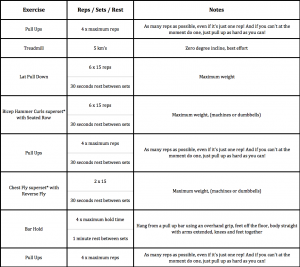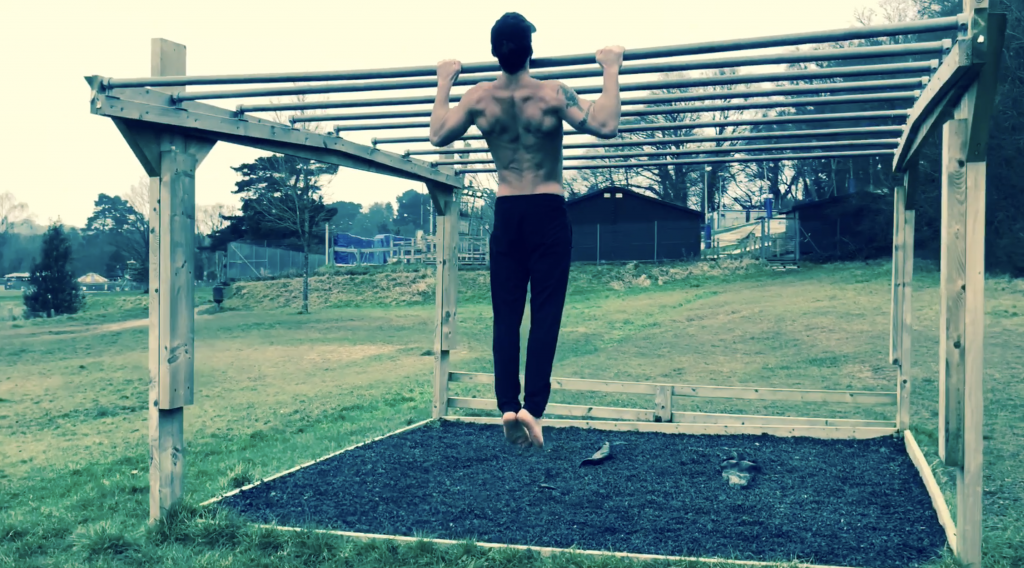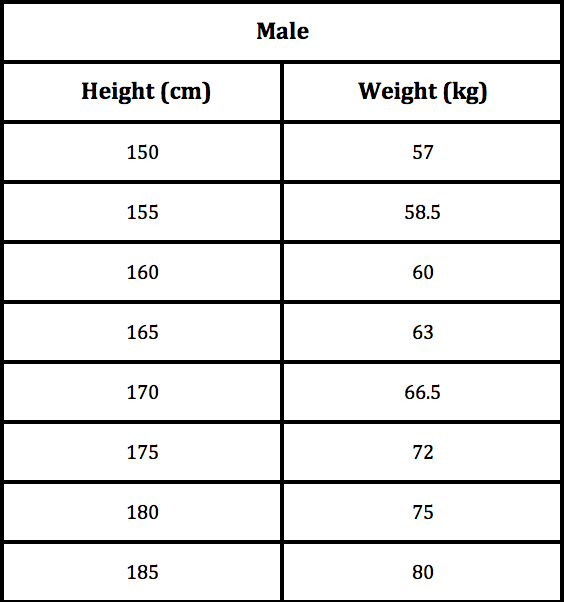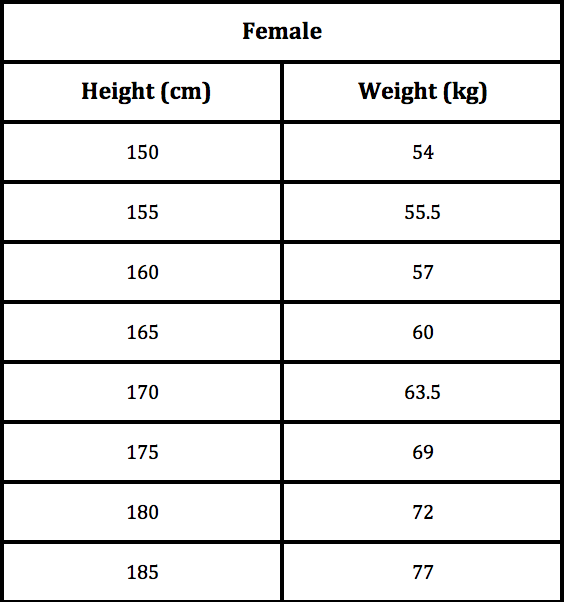Pull Ups: The Magic Formula
The key to performing pull ups is balancing muscular strength and endurance with your body’s weight. In other words, you need to have above average strength and fitness for your size to do a pull up, and if you haven’t got that yet, you need to be striving for it.
So what is above average? Well, most people can lift a bag of sugar, right? And most people can carry their shopping; these are ‘average things’. Now think about those people that can lift huge weights, or pull a car or even a bus. The people that do these things are human, just like you and I, but this isn’t your ‘average’. So think about that, specifically about where you see yourself fitting in in life, in either one of those scenarios. If you feel more comfortable shifting towards the latter, then that’s what I mean by striving to be above average. It’s a mindset, and you need to get it right!
I’m about to tell you exactly how to perfect your pull up technique and how to perform ten pull ups in only eight weeks, even if right now you are unable to do one.
Once you’ve completed this plan, with the help of Shredify, you’ll be able to start moving on to new challenges such as L-Sit Pull Ups.
We estimate that 90% of the adult population cannot perform one correct pull up and less than 1% can complete 10. We live in an age where we have unlimited information at our fingertips, providing us with all that we need to know as to the benefits of becoming stronger, fitter and healthier, so does anyone else think this is crazy that so few people can perform a simple pull up?
It’s About Mindset!
The key to performing pull ups is balancing muscular strength and endurance with your body’s weight. In other words, you need to have above average strength and fitness for your size to do a pull up.
In, 2016 I could achieve ten pull ups in one set, now in 2018, I can perform 50 pull ups in 40 seconds.
Nothing comes easy and once upon a time I was also a beginner at these, and through learning, and developing my technique, I’d like to be able to help others achieve their potential.
Fundamental Training Principles
To get through this training plan, I want you to focus on three of my core training principles:
- Strength
- Consistency
- Sheer will
This training plan will require a lot of effort and focus, so ignore all distractions. You need to focus on the mindset of bettering and improving yourself. You’ll need to be accountable for your successes as well as your failures along this journey.
It’s not as easy as just jumping up to a bar and pulling, yes we like to say it is but that’s the thing, that there lies the magic in making it look good, by making it look effortless.
To get the desired result, you need to build a solid foundation. You then need to take positive steps towards achieving the result, consistently.
You need to get your mind right, and start every single day with the mindset that even if you don’t succeed, that it’s not a failure, it’s just another opportunity to discover any weakness, then work on that weakness to get better!
Your Hands Will Break Before Getting Strong
During your training, you’ll get sore hands, which will result in tough skin developing on your pads called calluses. Some personal trainers out there may recommend wearing gloves, but I don’t! Not because I want you to have sore hands but because you need to feel the bar, make it a part of you. Your grip will then get strong in line with the rest of your body. During my training, my calluses had built up to the point that they ripped off!
Torn hands after training (they recovered, don’t worry 🙌🏽)
You can avoid calluses by performing the following treatment:
- Use a pumice stone or foot file to rub away the dead and hard skin gently
- Add Epsom salts to warm water and soak your hands for 10 minutes
- Apply a moisturising cream
Tip: Although you wouldn’t want the above to happen! I’d recommend trying to keep a little bit of dry padding if you can. This will protect your hands from any pain through further training.
Correct Pull Up Technique
Step 1:
Hang from a bar with your hand’s shoulder width (or wider) apart, use an over grasp grip so that the palms of your hands are facing forward; your legs should hang straight.
Step 2:
Retract your shoulder blades while simultaneously pulling yourself upward until your chin is above the bar, then lower your body back down until your arms are at full extension with no bend at the elbow; your legs should remain straight throughout the movement with no bending at the knees or hips.
Body To Weight Ratio for Pull Ups
The following tables (1. for male and 2. for female) represent the ideal body weight against height that you will need to be, to achieve ten pull ups. To be successful and to be able to make ten pull ups after just eight weeks by following this plan, you’ll ideally need to be within 8Kg’s of the ideal weight against height tables.
Before you start this eight week training plan, measure your weight, and attempt as many pull ups as you can with the correct pull up technique described above, make a note of how many you achieve.
Table 1: Male – Ideal weight against height
Table 2: Female – Ideal weight against height
If you need to reduce your body weight:
Decrease your current calorific intake by 1000 calories per day, this will result in a 2lb weight loss per week, and in 8 weeks you can reduce your weight by over a stone (16lbs).
If you need to gain body weight:
Increase your current calorific intake by 1000 calories per day, as this will result in an approximate weight gain of 2lb per week, and in 8 weeks you can increase your weight by over a stone (16lbs).
Whether you aim to lose or gain weight, stick to a high protein, low-fat nutrition plan and adjust your carbohydrates to suit your calories.
Here’s a little tip; Stay dry for eight weeks, so no drinking alcohol, and get plenty of sleep! Finally, keep flushing out your body’s toxins and fatty acids by drinking 3 – 4 litres of water per day.
Get your weight to strength ratio right, and you’ll feel at home on the bar!
The Pull Ups Training Plan
Aim: Increase strength, endurance and conditioning
Targetted muscles: Back, biceps and shoulders
The following training plan (table 3) should be performed every other day for eight weeks (28 workouts):

*A superset is when you complete one exercise back to back with another exercise without any rest in-between.
Note: The worst thing you can do when performing any exercise is to compromise your form, as this can lead to injury and lack of results. For the correct technique of all exercises, check out Shredify.
This plan is designed to improve muscular endurance, strength and conditioning. It’s so important to recognise the latter phrase here, ‘conditioning’. This plan will be the key driver towards you making progressions.
What Is Conditioning
Conditioning takes time and effort, mostly it’s all about consistency and repeating the same movement over and over again. If you wanted a simple explanation, I’d say its like walking; we’ve been walking all our lives, and I imagine you’re pretty good at it, you may fall over every now and again but who doesn’t right?.’ The point is that most of us can walk quite well because we do it every day of our lives. Use this analogy and translate it to pull ups; it is a learnt movement that becomes easier through conditioning.
A by-product of this training plan is conditioning!

The Science Behind Conditioning:
During the pull up, electrical impulses are sent from the brain via your nervous system, (known as the neuro-muscular pathway), to your muscles causing them to fire, and allow movement.
The NMJ (neuromuscular junction) is the point where electrical impulses meet the muscles. The NMJ is a type of synapse (a point at which different types of nerve cells meet). This synapse then triggers muscle contractions via chemical reactions.
We must condition the NMJ through repetition, which will improve reactions and muscle memory.
What Muscles Are Worked During a Pull Up
The main muscle groups worked when performing pull ups:
- Latissimus dorsi (known as lats or upper back)
- Biceps
- Deltoids (shoulders)
- Core (abs, oblique’s, serratus anterior and lower back)
The core muscles should be strong and conditioned as it is your core that will stabilise you on the bar.

What Are the Different Types of Pull Ups?
There are various techniques used when performing pull ups in the ‘strict form’. Each method or type will use slightly different proportions of muscles and muscle fibres.
Here’s an example:
Most people find it easier to perform under grasp pull ups than over grasp pull ups. These type of pull ups are easier because the palms of your hands are facing towards you, thus recruiting the medial head of the biceps in greater proportion as well as recruiting more muscle fibres in the forearms. The lats (upper back muscles) are the primary muscle worked during all pull up variations. Conditioning the lats are going to be extremely important for achieving your pull ups.
There Are Five Main Pull Up Variations
- Wide arm pull ups
- Close arm pull ups
- Over grasp grip
- Under grasp grip
- Scapular pull ups
Other pull up techniques include; the ‘kipping pull up’, and ‘butterfly pull up’. These both use momentum in the isometric plane. This involves forcing the body away from the bar when the chin is above it, using different degrees of leg swing.
I won’t cover the butterfly and kipping pull ups here as they’re more of a ‘Cross Fitters’ exercise. What we are learning here is pull ups in their strict form.
Common Pull Ups Mistakes and Bad Habits
– Swinging: If it were CrossFit pull ups we were talking about, I’d say ‘fine’, but it’s not, so don’t. Unfortunately, when we get tired, we swing our bodies! We then use the backward and upward momentum to drive our chin above the bar.
– Legs out in front or behind: Shortening a lever makes an exercise easier, that is why when you see folks getting tired during their set, their legs curling up behind them or stretching out in front of them as though they are climbing an invisible ladder.
– Half reps: Also known as ’Arthur’ reps or at least that will be your name if you don’t extend your arms or get your chin over that bar! 😉
If you’re only travelling half of the range of movement, you’re not doing proper pull ups.
If you train your muscle in a shortened length of plane, you will never achieve total strength gains. You will also slow down any real progress.
Avoidance: Imagine you’re trying to demonstrate the pull up to a seasoned athlete; No one wants to feel awkward here, so rather than pulling off extra reps with bad form, focus on your technique and developing your muscular strength and endurance in the right way. You’ll in turn progress faster, and demand more respect.
You’re Ready to Start!
Well, that’s it, easy right! Just adjust your weight if needed, follow the training plan, and become a master of pull ups! The key to the above however is to not just ‘go through the motions!’ You will need to give 100% effort to every rep.
After you have completed this plan, check out Shredify’s body shape goals. Each programme is designed based on your current level of fitness, and then programmes evolve as you progress. You won’t be disappointed! Good luck!
‘Do the impossible.’



